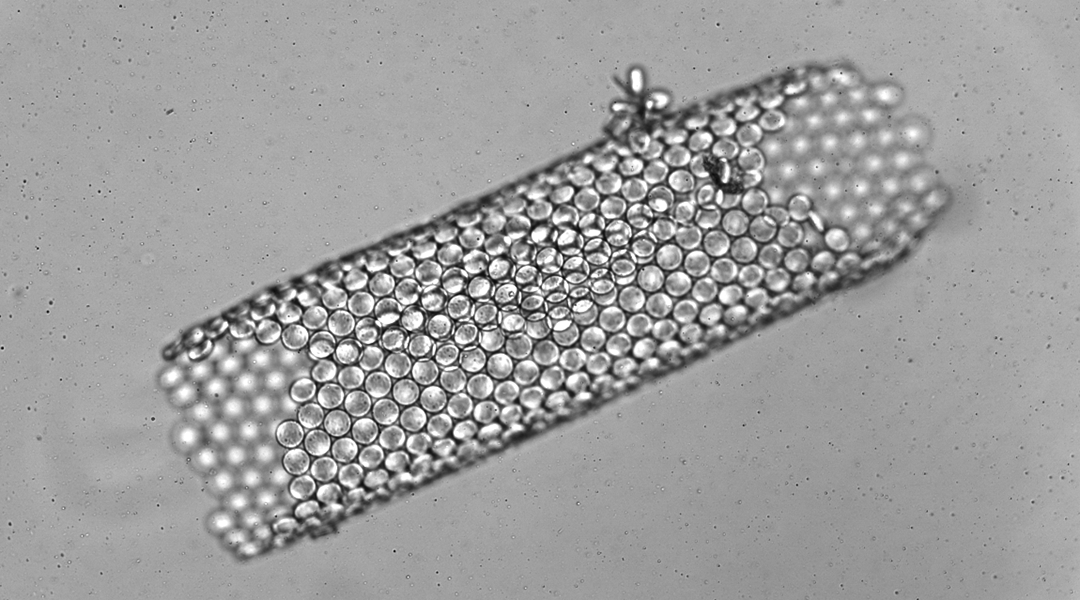Microrobotics has enormous potential to revolutionize many fields, from healthcare to microfabrication, as microscopic robots can access difficult-to-reach areas and operate with an unprecedented degree of precision.
However, their inherently small size means that, as individuals, they are unable to impart significant forces or deliver large quantities of agents. An additional challenge is that for many applications, microrobots would have to perform a variety of functions to complete a single task, which is not conducive to having one, set design.
To solve both of these issues, researchers from the University of Chemistry and Technology in Prague have devised a method to organise and connect simple, micrometer-scale robots into larger moving structures.
In the study published in Advanced Intelligent Systems, they used disc-shaped microrobots that are 100µm wide and 25µm thick and composed of a photo-responsive hydrogel. The hydrogel shrinks reversibly in response to light as water is expelled from the network of the gel.
As the gel shrinks and expands it switches between “sticky” and “slippy” states. Aiming the laser at one side of the microrobot means that its anchoring point to the surface alternates switches sides. This then allows the microrobots to crawl over a surface in any direction, resembling microscopic slugs.
These microrobots can be brought together by manually navigating individuals to pre-designated locations. However, such “one-at-a-time” assembly is tedious, time consuming, and difficult to scale up. Instead, the researchers employed a self-assembly process, where hundreds of microrobots assemble simultaneously by sliding to the bottom of a bowl-shaped depression.
Here, the choice of disc-shaped microrobots presents an advantage as when many discs are pushed or pulled together into large groups, they form a repeating pattern called a dense hexagonal packing. In this arrangement, each disc is surrounded by six neighbours, and this pattern spreads across the whole assembly.
Because of this repeating pattern, the assembly can be treated as a single sheet. This method enabled the researchers to assemble the microrobots into ordered, crystalline sheets, up to several millimetres in diameter. The shape of the depression is not important for forming the sheets, which means this method could be used in a variety of environments.
Once the robots are assembled into the desired structure, they must be connected to each other to turn the resulting structure into a useful object. Here, the researchers exploited a unique property of hydrogels. Hydrogels are described as having both solid-like and liquid-like properties. The solid properties are easily recognizable – they retain their shape and behave mechanically like elastic materials, such as rubber. What gives them liquid properties is their hydrated, porous structure, which means that sufficiently small molecules can diffuse through them and their internal volume is still accessible.
This property is exploited to enable the connection of adjacent microrobots by allowing extra crosslinking molecules to diffuse throughout the assembly, including within the individuals. Subsequently, illumination with UV light initiates a crosslinking reaction and forms molecular bridges between the microrobots, binding them permanently.
By probing the conditions of this reaction, the researchers were able to form gradients along the thickness of the microrobot disks, causing them to bend into dome shapes. The shape and intensity of the UV illumination can then be altered to transduce the individual bending of the microrobots to form a variety of 3D shapes such as rolls, domes, tubes, and grabbers.
Because these larger scale structures are composed of the photo-responsive microrobots, they can be actuated using the same laser used for the microrobot locomotion. The actuating tubes can be used to pump fluids, and the large rolls are demonstrated pushing a solid object that would be impossible to be manipulated by individual microrobots.
“Microrobots that have the ability to rearrange into different designs ‘on-the-go’ would be highly advantageous,” said group leader, Ivan Rehor. “For example, a collection of robots could pass through small gaps individually, before assembling into a pumping device.
“Our ongoing research is seeking strategies to enable reversible binding of the microrobots, whilst retaining the 3D shape morphing. With reversibility, microrobots could perform a function, disassemble, and be used for subsequent functions.”
Reference: Ivan Rehor, et al., Hydrogel Microrobots Self-Assembled into Ordered Structures with Programmable Actuation, Advanced Intelligent Systems (2023). DOI: 10.1002/aisy.202300096
Disclaimer: The author of this article was involved in the study

















